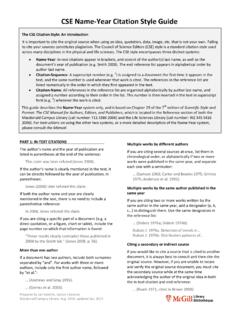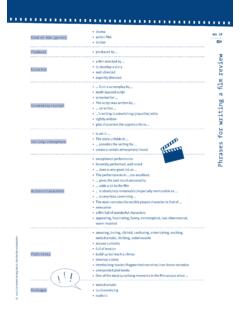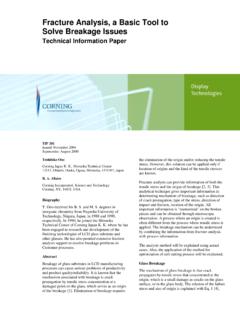Transcription of Methods for Protein Analysis SDS-PAGE
1 Methods for Protein Analysis1. Protein Separation MethodsThe following is a quick review of some common Methods used for proteinseparation: SDS-PAGE (SDS-polyacrylamide gel electrophoresis) separates proteins mainlyon the basis of molecular weight as opposed to charge (which is swamped out by the excess of Protein -bound SDS) or folding (proteins are largely denatured inSDS). In the ideal picture, the distance migrated by the Protein in a given time isinversely related to the logarithm of its molecular weight:log (mol wt.)Distancemigratedon gelHowever, factors other than molecular weight alone ( , glycosylation or astrongly hydrophobic character) can also affect the migration of a Protein on anSDS-PAGE gel, as discussed in focussing separates proteins on the basis of their balance of acidic(negatively charged) vs. basic (positively charged) amino acid residues, whichdetermines a property known as the Protein s isoelectric point [pI], the pH atwhich the Protein s net charge becomes exactly zero.
2 Proteins that differ by aslittle as one charged residue ( , the mono- and di-phosphorylated forms of agiven Protein ) can be separated using this method. Conversely, however,proteins with very similar pI values but very different sizes can run at the chromatographic Methods are frequently used for Protein or (more often)peptide separation. High-performance liquid chromatography (HPLC) can beused to separate and to purify proteins/peptides based on size, charge or overallhydrophobicity. Thin-layer chromatography (TLC) can also be used to separateout peptides ( , derived from proteolytic digestion of a Protein ) based onsimilar properties. Both of these Methods are very useful adjuncts to gel-basedapproaches, particularly for peptide Analysis and for preparative purposes ( ,to purify rather than simply to analyze proteins).Two-dimensional (2-D) gel electrophoresis is a powerful gel-based methodcommonly used for global Analysis of complex samples ( , when we areinterested to characterize the full range of proteins in a sample, not just a fewspecific proteins).
3 In this technique the Protein is run first in a narrow (oftentube-shaped) isoelectric focussing gel, which as already noted separates proteinson the basis of their isoelectric points (acid vs. basic character). The isoelectricfocussing gel is then placed over an SDS-PAGE gel and run on the latter in theperpendicular dimension:(Original IEF Gel)Step 2 -Run SDS-PAGEin this dimensionMost acidicMost basicStep 1 - Isolectric Focussing (IEF) Gel(Final positions ofprotein spots)In the final gel, proteins run not as bands but as spots, and the position of eachprotein spot depends on both its size and its charge properties. This provides amore powerful means to separate proteins than does either SDS-PAGE orisoelectric focussing Western BlottingThe most common version of Western blotting is known as immunoblotting. Inthis technique a sample of proteins is first electrophoresed by SDS-PAGE toseparate the proteins on the basis of their molecular weights. The wet gel is thenplaced against a sheet of nitrocellulose and placed in a special type ofelectrophoretic chamber.
4 The gel (sandwiched against the nitrocellulose) is thensubjected to an electric field which causes the proteins to migrate out of the geland onto the nitrocellulose sheet, to which the proteins become tightly (in effectirreversibly) adsorbed. The nitrocellulose with its tightly bound proteins canthen be blotted or probed with an antibody (known as a primary antibody)which (in theory) will bind to the nitrocellulose sheet only in places where theprotein(s) recognized by the antibody are adsorbed. We can then determinewhere on the nitrocellulose blot the primary antibody binds (a clue to theidentity of the Protein ) and how intense the binding is (a clue to the amount ofthe Protein present).The above conceptual description neglects a few technically important steps andsome key factors that determine how well the method works in practice. Sinceinsufficient control of these factors can create both false negative and falsepositive results, we will briefly discuss them here.
5 To help make things concrete,let us suppose that we are studying a specific kinase (MyKinase) that isrecognized by a particular mouse monoclonal antibody (anti-(MyKinase), of theimmunoglobulin G1 [IgG1] class of mouse antibodies).The first complexity that we should note in immunoblotting concerns how wedetect binding of the primary antibody (anti-(MyKinase)) to the blot. In principlethe primary antibody could be radioactively or otherwise labeled in a mannerthat would allow us to determine directly ( , with a simple autoradiogram)where on the blot it had bound. A more sensitive and efficient, and thereforemuch more common, method uses a two-step approach with two differentantibodies. In this approach the nitrocellulose blot is first incubated with anti-(MyKinase), then washed and further incubated with a secondary antibodywhich binds to the primary antibody (say, a goat antibody which binds to anymouse IgG1 antibody) and which is modified in some manner to make it easy todetect.
6 The most common secondary antibodies in current use are chemicallymodified so that they catalyze chemiluminescence (production of small amountsof light) when the appropriate reagents are added. When a nitrocellulose blottreated with anti(MyKinase) and secondary antibody is soaked in a solution ofthe chemiluminescence reagents, then placed against a piece of film and left inthe dark, the film will become exposed (due to local light production) only wherethe secondary antibody is bound to the blot, and hence (in theory) only where(MyKinase) is present on the nitrocellulose blot. The key steps inimmunoblotting at a conceptual level can thus be summarized as shownschematically below:Transfer tonitrocelluloseSDS-PAGE GelNitrocellulose BlotIncubate withprimaryantibody(Nitrocellulose blot)(Nitrocellulose blot)Incubate withsecondaryantibodyAddchemiluminescenc ereagentsThe second complexity in immunoblotting is one whose origin may already haveoccurred to you.
7 Nitrocellulose is a very sticky matrix, which is why it canefficiently adsorb all of the proteins transferred to it from the original , after the initial Protein sample is adsorbed to the nitrocellulose, wemust have some way to reduce the stickiness of the nitrocellulose before weincubate it with the primary antibody, anti-(MyKinase, so that the antibody willbind to the nitrocellulose sheet only where it specifically recognizes (MyKinase).This is accomplished by blocking the nitrocellulose after it adsorbs the proteinsfrom the gel (and without displacing these proteins from the nitrocellulose) byincubating it in a solution rich in proteins that our primary (or secondary)antibodies does not recognize. The most commonly used blocking solution formost purposes is reconstituted nonfat dry milk. Once the nitrocellulose isproperly blocked, meaning that all the remaining sticky sites have been tiedup by proteins from the blocking solution, the primary and secondary antibodieswill bind tightly to the blot only where they can bind to proteins already on theblot, not to the nitrocellulose close attention to my last statement: [After blocking] the primary andsecondary antibodies will bind tightly to the blot only where they can bind toproteins already on the blot, not to the nitrocellulose itself.)
8 This does not meanhowever that the antibodies may not bind weakly to the blot elsewhere throughrelatively nonspecific interactions. Therefore, a further important technicalelement in immunoblotting is to wash the blots thoroughly after each incubationwith antibody. This (if properly done) will minimize the level of nonspecificbinding of antibodies to the blot and hence reduce both the backgroundstaining and the possible identification of false-positive spots. Carefulblocking, and later washing to remove primary and secondary antibodies thatare not tightly bound to the nitrocellulose blot, are crucial for the success of animmunoblotting s now outline the sequence of steps in a real immunoblotting experiment: Run SDS-PAGE Transfer to nitrocellulose BLOCK Incubate with primary antibody WASH Incubate with secondary antibody WASH Soak blot with chemiluminescence reagents Expose film to reagent-soaked blot Develop film Observe darkened spots/bands on film (align with markers on original gel)The quality of the experimental technique, and also on some cases the quality ofthe antibodies, can have a huge effect on the quality of the final additional complexities in immunoblotting experiments are probablyworth noting.
9 First, a given primary (or more rarely a secondary) antibody maynot be very pure or very specific, and hence it may bind to proteins other thanthe target of interest to us. In this case we will see extra bands on animmunoblot that have nothing to do with our Protein of interest. (In fact,immunoblots frequently have extra bands around the region where antibodyheavy chains run, even if they are otherwise clean ). For this reason amongothers, authors will usually show in their papers only the small region of animmunoblot where the Protein of interest is found. Second, if our primaryantibody is a monoclonal antibody, in some cases it may fail to bind to the target Protein if the antibody-binding region of the latter (the epitope) has beencleaved off or is posttranslationally modified in some manner that significantlychanges its reactivity with the antibody. This can be a useful effect (for example,we can determine whether a Protein has lost a small region at its N-terminus byprobing replicate blots with two primary antibodies, one of which recognizes theN-terminus while another recognizes another region of the Protein ).
10 A final useful feature of immunoblots is that on a given blot (or on a given set ofblots that are run, transferred, blocked, etc. at the same time with exactly thesame solutions), the integrated intensity of a given Protein band is proportionalto the amount of the Protein present. This can be very useful, for example tocompare the levels of a given Protein present in different cell samples. It ishowever difficult to compare intensities of bands between blots run in differentexperiments (unless one uses purified Protein as an internal standard In eachexperiment, which few researchers do) - too many factors can differ variation of the above method is Far-Western blotting, in which thenitrocellulose blot is probed, not with an antibody but rather with a labeledsoluble Protein of interest (we ll call it P). The probe Protein P is radiolabeled ormodified in some other manner that allows it to be easily and sensitivelydetected where it has bound to proteins on the blot.















